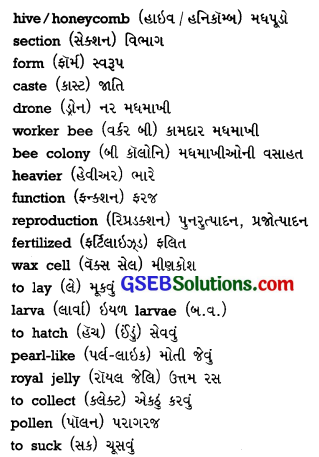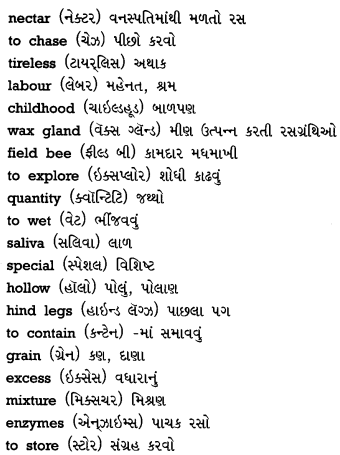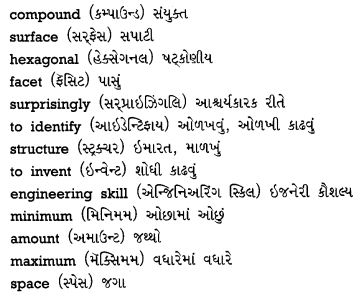Gujarat Board GSEB Solutions Class 10 English Second Language Supplementary Chapter 9 Wonderful Workers Textbook Exercise Questions and Answers.
GSEB Class 10 English Textbook Solutions Supplementary Chapter 9 Wonderful Workers (Second Language)
GSEB Class 10 English Wonderful Workers Text Book Questions and Answers
Read the passage and answer the questions.
(1) The queen bee is nearly 2.5 times longer and 2.8 times heavier than a worker bee. Her function is reproduction. She lays 1000 to 2000 fertilized eggs every day. Some of the eggs will develop into worker bees or into queens. But this depends on the size of the wax cell in which eggs are laid and on the type of food given to the larvae.
![]()
The queen also lays unfertilized eggs from which only drones develop. The bees cannot live long without a queen. So when the queen dies, the bees choose some three-day-old eggs and hatch them. From that pearl-like egg a larva comes out. It is taken to a big wax cell and fed with royal jelly. Therefore it develops into a queen. [Page 40]
Questions:
(1) What is the size of the queen bee compared to the worker bee ?
(2) What is the function of the queen bee ?
(3) How many fertilized eggs does the queen bee lay every day?
(4) What do the eggs develop into ?
(5) Some eggs develop into worker bees or queens. What does this depend on ?
(6) From what do drones develop ?
(7) When the queen dies
(8) What do the drones do with the larva ?
Answers :
(1) The queen bee is nearly 2.5 times longer and 2.8 times heavier than a worker bee.
(2) The function of the queen bee is reproduction.
(3) The queen lays 1000 to 2000 fertilized eggs every day.
(4) The eggs develop into worker bees or into queens.
(5) This depends on the size of the wax cell in which eggs are laid and on the type of food given to the larvae.
(6) Drones develop from the unfertilized eggs laid by the queen.
(7) When the queen dies, the bees choose some three-day-old eggs and hatch them.
(8) Drones take the larva to a big wax cell and feed it with royal jelly so that it develops into a queen bee.
![]()
(2) Worker bees spend their whole short lives in tireless labour. They have no childhood. From the third day of their life they have to clean the walls and floors after the young bees go out. From the fourth day they become ‘house bees’ and feed other bees with honey and pollen. From the seventh day they start producing royal jelly. From 12th to 18th days they develop wax glands and work on the building up of the honeycomb.
From 15th to 18th days they become field bees. Now they fly to explore and collect nectar and pollen. They collect large quantities of pollen, make it wet with saliva, mix nectar into it. Then they place it in special hollows or ‘baskets’ in their hind legs. Two baskets contain around four lakh grains of pollen! In those baskets or ‘honey stomachs’ excess water is absorbed. [Page 41]
Questions:
(1) Why do the worker bees have no childhood ?
(2) What do the worker bees do from the third day of their life ?
(3) What do they do from the fourth day ?
(4) What do they do from the seventh day ?
(5) What do the worker bees do from the 12th to 18th day?
(6) What do they do from the 15th to 18th day?
(7) What do they do after collecting pollen ?
(8) What do the honey stomachs do ?
(9) How many grains of pollen are stored in two baskets ?
Answers:
(1) The worker bees have no childhood because they spend their whole short lives in tireless labour.
(2) From the third day of their life, the worker bees clean the walls and floors after the young bees go out.
(3) From the fourth day, they become ‘house bees’ and feed other bees with honey and pollen.
(4) From the seventh day they start producing royal jelly.
(5) From 12th to 18th day, the worker bees develop wax glands and work on the building up of the honeycomb.
(6) From 15th to 18th day, they become field bees and fly to explore and collect nectar and pollen.
(7) After collecting pollen, they make it wet with saliva, mix nectar into it and place it in special hollows or ‘baskets’ in their hind legs.
(8) Honey stomachs absorb the excess water from the pollen and nectar.
(9) Around four lakh grains of pollen are stored in two baskets.
(3) The explorer bees tell their sisters about direction and distance of flowers through definite movements which we can call ‘dances’. A round dance suggests that the flowers are quite near. The shuffle dance suggests that the bees should be ready for a long flight. Certain other movements are also used to indicate even the direction of the nectar source of flowers.
![]()
Now let’s look into their eyes. Bees have five eyes: two compound ones and three simple ones. The surface of a compound eye of a worker bee has nearly 5000 hexagonal facets, whereas drones have about 8000. But surprisingly bees are poor in identifying colours. They can identify blue, yellow and white colours only. They cannot see the red colour at all! [Pages 41 – 42]
Questions :
(1) What do the explorer bees indicate through dances ?
(2) What does a round dance suggest ?
(3) What does a shuffle dance suggest?
(4) How many eyes do the bees have ?
(5) What do you know about a compound eye of a worker bee ?
(6) What do you know about a compound eye of a drone ?
(7) Which colours can the bees identify ?
(8) Which colour can the bee not see at all ?
Answers:
(1) The explorer bees indicate the direction and distance of flowers through dances.
(2) A round dance suggests that the flowers are quite near.
(3) A shuffle dance suggests that the bees should be ready for a long flight.
(4) The bees have five eyes : two compound eyes and three simple eyes.
(5) The surface of a compound eye of a worker bee has nearly 5000 hexagonal facets.
(6) The surface of a compound eye of a drone has nearly 8000 hexagonal facets.
(7) The bees can identify blue, yellow and white colours.
(8) The bees cannot see the red colour at all.
Vocabulary Recognition
Select the word having the nearest meaning.
Question 1.
section
A. selection
B. part
C. separate
D. class
Answer:
B. part
![]()
Question 2.
function
A. selection
B. election
C. use
D. job
Answer:
D. job
Question 3.
collect
A. gather
B. mix
C. combine
D. call
Answer:
A. gather
Question 4.
chase
A. run on
B. run into
C. run before
D. run after
Answer:
D. run after
Question 5.
labour
A. exercise
B. relaxation
C. easy work
D. hard work
Answer:
D. hard work
![]()
Question 6.
explore
A. search
B. invent
C. discover
D. research
Answer:
A. search
Question 7.
deposit
A. take
B. put
C. collect
D. gather
Answer:
B. put
Question 8.
transfer
A. export
B. import
C. move
D. send
Answer:
C. move
Question 9.
several
A. many
B. few
C. some
D. none
Answer:
A. many
![]()
Question 10.
definite
A. estimated
B. exact
C. unsure
D. imperfect
Answer:
B. exact
Question 11.
indicate
A. implicate
B. speak
C. hide
D. show
Answer:
D. show
Question 12.
facet
A. tap
B. faucet
C. face
D. view
Answer:
C. face
Question 13.
structure
A. idea
B. formation
C. thought
D. brainwave
Answer:
B. formation
Question 14.
minimum
A. nil
B. average
C. the most
D. the least
Answer:
D. the least
Question 15.
maximum
A. the least
B. the most
C. height
D. summit
Answer:
B. the most
![]()
Question 16.
space
A. full
B. empty
C. place
D. blank
Answer:
C. place
Wonderful Workers Summary in Gujarati
ભાષાંતર ઇસ્પેક્ટર ઍન્ડરસન ફરજ પર નહોતા. તેઓ હમણાં જ થોડા મિત્રોને મળવા સ્ટેશન પર આવ્યા હતા, પણ તેમની ગાડી એક કલાક મોડી હતી. તેઓ જ્યારે ધીમે ધીમે મુખ્ય પ્લેટફોર્મ પર જતા હતા ત્યારે એક અસ્વસ્થ નજરવાળા માણસ તરફ તેમનું ધ્યાન ખેંચાયું. પછીથી એ પ્રવાસીઓના ટોળામાં ભળી ગયો.
થોડી મિનિટોમાં જ ઇન્સ્પેક્ટરે તેને શોધી કાઢ્યો. તે સ્ટેશનની કૉફી શૉપમાં જઈ રહ્યો હતો. હવે તેના હાથમાં ચામડાનું પાકીટ હતું. તે માણસ પાકીટને ખુરસી અને દીવાલ વચ્ચે મૂકીને ખૂણાના ખાલી ટેબલ પાસે બેસી ગયો.
આ માણસ પર શી શંકા થાય છે?
ઇન્સ્પેક્ટરે તેનો પીછો કર્યો અને તેના જ ટેબલ પાસે જઈને બેઠા અને તેને તેની પાસેના પાકીટની માલિકી વિશે થોડા પ્રશ્નોના જવાબ આપવા સ્ટેશન માસ્તરની ઑફિસમાં આવવા કહ્યું. માણસે ગુસ્સે થઈને પાકીટ પોતાનું જ હોવાનો દાવો કર્યો, પણ તે સાથે જવા સંમત થયો.
સ્ટેશન માસ્તરની ઑફિસમાં ટેબલ પર પાકીટ ખોલતાં જ તેમાં કાગળોની એક ફાઈલ અને 20,000 ડૉલર ભરેલું એક પાકીટ મળી આવ્યાં. “અરે આ મારું પાકીટ નથી.” મિ. ફિન્કે મોટા અવાજમાં કહ્યું. ‘મિ. ફિન્ક, આપણે આ પાકીટ ખોલ્યું તે પહેલાં તમે અમને કહ્યું કે તે પાકીટ તમારું જ હતું અને તેમાં માત્ર બે મૅગેઝિન્સ હતાં. હવે, તમે માલિક નથી એમ કહો છો. એ વિશે તમારે શું કહેવું છે?” ઇન્સ્પેક્ટરે પૂછ્યું.
મિ. ફિન્ક મૂંઝાઈ ગયા. “આજે સવારે ક્લૉકરૂમમાં મેં સોંપેલું તે આ પાકીટ નથી.” તેણે કહ્યું, “તેમણે મને બીજા કોઈનું (પાકીટ) આપ્યું હોવું જોઈએ. એ બરાબર મારા પાકીટ જેવું જ દેખાય છે. પણ હું જોઈ શકું છું કે તે (પાકીટ) મારું નથી. મારા પાકીટને તો તાળું વાસેલું હતું અને તેમાં કેટલાંક મૅગેઝિન્સ જ હતાં. હું ગાડીમાં તે વાંચતો હતો. આટલા પૈસા સાથેના આ પાકીટને તેના માલિકે આમ ખુલ્લું તો ના જ મૂકવું જોઈએ. એ ભૂલથી મારું પાકીટ લઈ ગયા હશે તો તે બહુ ખુશ નહીં થાય.”
![]()
“મને ખાતરી છે કે એમ નહિ થાય,” ઇન્સ્પેક્ટરે કહ્યું. “જેમાં માત્ર બે જ મૅગેઝિન્સ હોય તેવું પાકીટ કોઈ સાચવવા શા માટે મૂકે તેનું મને આશ્ચર્ય થાય છે.” સાફ વાત છે,” મિ. ફિનકે કહ્યું. “હું એક દિવસની ફરતી પ્રવાસી ટિકિટ લઈને આજે સવારે જ બાર વાગ્યા પહેલાં આ શહેરમાં આવ્યો છું. ગાડીમાં હું મૅગેઝિન્સ વાંચતો હતો. થોડાં જૂનાં પુસ્તકો ખરીદવાની આશાએ હું આ પાકીટ લઈ આવ્યો પણ હું પુસ્તકભંડારમાં ગયો નહિ, કારણ કે મને એક મારો જૂનો મિત્ર મળી ગયો અને તે મને તેના ઘેર લઈ ગયો.”
એટલા માટે તમે તમારું પાકીટ અહીં મૂક્યું?”
બરાબર,” મિ. ફિન્કે કહ્યું. “હું એ સાથે લઈને ફરવા નહોતો ઇચ્છતો, તેથી (પાકીટ) અહીં મૂકી હું મારા મિત્ર સાથે ગયો. આવવા-જવાનું ટેક્સી ભાડું આપ્યું… મઝા કરી.” મિ. ફિન્કના ખુલાસામાં તમને કંઈક અતાર્કિક વાતનો ખ્યાલ આવ્યો? એ શી છે? નસીબદાર છો,” ઇન્સ્પેક્ટરે કહ્યું. “હવે તમને તમારાં બધાં ખિસ્સામાંની વસ્તુઓ કાઢી આ ટેબલ પર મૂકવામાં કંઈ વાંધો તો નથી ને?”
‘જરાય નહિ,” મિ. ફિઝે કહ્યું. “મારે કશું જ છુપાવવાનું નથી. તમને જેટલો વહેલો સંતોષ થાય તેટલો વહેલો હું જઈ શકું. મારે આ પાકીટ ક્લૉકરૂમમાં લઈ જઈ મારું (પાકીટ) હજુ પણ ત્યાં છે કે નહિ તે જોવું પડશે.” આ શંકાસ્પદ વ્યક્તિ સાચું કહે છે કે નહીં તે જાણવા ઍન્ડરસન માટે મિ. ફિન્કનું નિવેદન અને તેના ખિસ્સામાંની ચીજો પૂરતી હતી.
આ શંકાસ્પદ વ્યક્તિ ગુનેગાર છે? તમે એ કેવી રીતે કહી શકો? તમે હજુ પણ નિર્ણય કરી શક્યા ન હો તો આ કડીઓ તપાસો… અથવા ઇન્સ્પેક્ટરને નિર્ણય પર આવવા માટે કડીઓ તરફના નિર્દેશો જુઓ. કડીઓ :
નીચે આપેલા દરેક વિધાનમાં એક એક ઉકેલ મળી આવે છે:
1. “મારા પાકીટને તાળું વાસેલું હતું.”
2. “એક દિવસની કરતી પ્રવાસી ટિકિટ પર આજે સવારે બાર વાગ્યા પહેલાં હું આ શહેરમાં આવ્યો છું.”
3.“મને થોડાં જૂનાં પુસ્તકો ખરીદવાની આશા હતી.” ઉકેલ:
શંકાસ્પદ વ્યક્તિના ખિસ્સામાંથી આ વસ્તુઓ નથી મળી : પાકીટની ચાવી. ટિકિટનો “પાછા ફરવાનો” ભાગ. પુસ્તકો ખરીદવા પૂરતા પૈસા (અને પૈસા ચૂકવવાનો બીજો કોઈ માર્ગ નથી). ફિન્કની ધરપકડ કરી તેના પર આરોપ મૂક્વામાં આવ્યો. પાકીટના માલિકને શોધી કાઢવાનું કામ સહેલું હતું.
સમાચારપત્ર ખરીદતી વેળાએ તેણે તેનું પાકીટ નીચે મૂકેલું અને આંખના પલકારામાં પાકીટ ગુમ થઈ ગયેલું એમ સિદ્ધ થયું. પાકીટના ઉઠાવગીરે સરસ મજાની વાત બનાવી કાર્ય પણ એ પાકીટમાંની ચીજો અને તેના ખિસ્સામાંની ચીજો એકસરખી હોવાનું દર્શાવવાનું ભૂલી ગયો. પ્રશ્નો અપકૃત્યો પર વિજય મેળવે છે.
Word Meanings:


![]()


Phrases

![]()